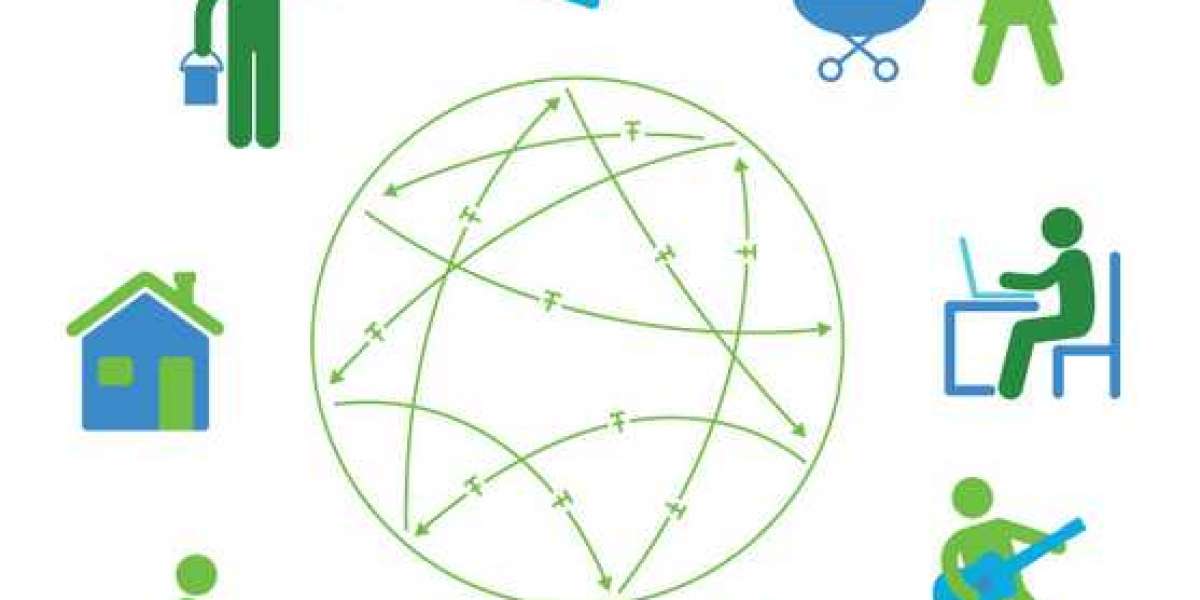There are many ways of exchanging what we have and can do for the things we need. ‘Money‘ is just one of them. The internet revolution has brought us new ways of exchanging things, without the unnecessary step of acquiring money first. L.O.V.E. is working towards providing the tools, platform, and means so that we can exchange and share what we have to offer, in exchange for what others provide, using not just 'Money', but alternatiuves such as Points, or a community currency.
One of the most knowledgeable people in the world on how to accomplish the goal is economist Thomas H. Greco, Jr.
Below are questions that he answers in realtion to this topic, with a focus on creating a Mutual Credit Sysytem, or Community Exchange System. The questions that were posed are quite pertinent and wide ranging, and the answers will be of interest to anyone who wants to understand mutual credit clearing and/or is considering designing and implementing one.
1. At the least minimum, how many businesses should be there in the network to begin tradingwith each other and should we be thinking about a maximum limit, if yes, then why and how?
It is not only a matter of numbers but also of variety of goods and services represented and the volume of sales. Conceivably, a mutual credit clearing network could begin with a single large trusted business that would have a large line of credit in proportion to their monthly sales volume, say a debit limit of 2 or 3 times monthly sales. All other members would need to earn credits before they could spend credits, they would have no line of credit until they had demonstrated their earning capacity within the network. But it would be better in many ways to have a number of “trusted issuers” who offer a variety of goods and/or services that are in regular demand, and who thus qualify to receive a line of credit.
In practice, commercial trade exchanges do not launch until they have a few hundred members that offer diverse goods and services, but in each case, the line of credit (debit limit) must be proportionate to their capacity to provide desired goods and services.
2. What are the differences in benefits for an issuing member, non issuing member?
An issuing member has been given a line of credit; they can spend before they earn. A non-issuing member does not (initially) have a line of credit; they must earn credits before they can spend credits. As they demonstrate their capacity to sell as well as buy, they may then qualify for a line of credit.
3. How can a non member of the network be a part of it?
A non-member can join the network to buy from, and sell to, the other members. Also, a non-member can be brought into the process by accepting vouchers issued by the network, as follows: It a member wishes to buy something from a non-member, s/he might ask the network administration to create voucher notes or tokens which they can draw against their account balance or line of credit. Those vouchers can then be offered as payment to a non-member vendor for goods or services. If the non-member is willing to accept them, the vouchers could then circulate outside of the network, but the voucher must have an expiration date to assure that the credits they represent will be returned to the network ledger when they are used to buy something from a network member.
4. In India, we have a savings culture as most people are still conservative when it comes to their money and also because there are major future investments for parents and families because culturally they are responsible for getting their children educated and married both requiring a lot of money. In that context, won’t people be uncomfortable in having just a medium of exchange and not able to save the currency which is a general tendency.
Surely, people need to save, and there are many ways to do that already. Savings can take the form of real assets, like precious metals, collectibles, tools, equipment, land, buildings, machinery, etc., or financial assets like corporate shares, bonds, savings deposits at a bank, etc.
Those ways remain available and assets can be acquired with an alternative currency as well as with conventional currency from anyone willing to accept the alternative currency in exchange for those assets. In the early stages, it is more likely that an alternative currency will be accepted for real assets than for financial assets, most of which must be acquired from banks and other institutions that are part of the dominant fiat money system. As I’ve suggested in my books, as a credit clearing exchange develops it can add savings mechanisms to it exchange services. Those who have surplus credit balances can shift them to their “savings” account just as people do now by shifting balances from their checking account to their savings account at their bank or credit union.
5. When the network reaches different sizes of member businesses like 20, 50, 100, 500, 1000: In these instances, how should the credit allocation be thought about, will it change according to the size or the types of businesses in the network, how to decide what number of possible issuers can issue at one time meaning how to think about the maximum credit issuance in a network?
I’m not sure what you’re asking here. The overall amount of credit that exists within a network at any one time will adjust itself according to the amount needed to complete all desired trades so long as account balances remain within allowed limits. Each account will be evaluated individually to decide its debit limit by applying a standard algorithm that is based mainly upon the sales volume of that account but also may include other factors such as the type of goods and services it provides (essential necessities that are in constant demand, or not), reputation with customers and/or suppliers, overall indebtedness (and risk of insolvency), sales trends, etc.
It is expected that most account balances will remain well within allowable limits but still provide the members with adequate liquidity. Those that are chronically close to their limit will be assisted in finding new customers and sales possibilities and/or developing new products and services that are in demand.
6. In India, in the informal sector (which is minimum around 60%), a transaction happens either fully in cash or partly in cash (not shown in records for tax purposes) and partly cheque/ bank transfer/ net banking etc. What needs to be done in such a scenario?
Under the present circumstances, government policies are typically antagonistic towards small and micro-businesses, and support market dominance by large corporations. It is hard to fault anyone for trying to avoid tax liabilities by using paper cash and other anonymous payment options. But the evident recent trend has been toward the elimination of cash by governments. Governments and banks everywhere seem determined to force a shift of monetary and financial transactions onto channels that allow every transaction to be tracked, and upon which taxes and fees can be levied. Furthermore, the complete replacement of cash by such digital currency systems will further tighten government control over how you spend your money, or whether you will be allowed to access it at all.
Mutual credit clearing is not intended to be a means for avoiding taxes. Rather it is a way of providing an economy with liquidity (a means of payment) that is independent of the banking system and supplemental to the supply of political money. See my web post, There ain’t no such thing as a free lunch: Principles of Credit, Exchange, and Finance, especially Addendum 2.
It is crucial to personal freedom, the survival of small businesses, and to local self-determination that such independent payment systems be established and reach significant scale prior to the complete centralization of money power into the hands of the political, banking and corporate elite.
7. Also in our informal sector, we have a data problem because most businesses are not incorporated hence most of them don’t maintain balance sheets which are public and can be trustworthy (again one problem being that they don’t want to show their actual income in order to avoid high taxes), so in that case how do we as an exchange operator could trust the issuing members?
The crux of organizing a system to provide the exchange function is for actors in the economy, be they unincorporated businesses, corporations, or individuals, is in deciding whom or what to trust with a line of credit, and to what extent (how much credit). There are numerous factors that might be considered in deciding credit lines. Each commercial trade exchange has its own system for doing this. Here below is one example. I’m not saying that it is the “right” formula but it serves as an example of a few factors that might be considered. Of course, local circumstances must ultimately be considered in deciding which factors to include and how much weight should be given to each. In the circumstances you describe, reliance will likely need to be primarily upon the reputation a business has among its suppliers and customers, and estimates of business volume based on self-reporting and confirmed by observations. Along with establishing the mechanisms for facilitating the exchange of value, we need to be building communities based on face-to-face interactions and personal knowledge of those we are doing business with.
Recent scandals have show that even the audited balance sheets of public corporations may not be trustworthy.
8. With the issuing principle, you explain in what quantity a business should issue its currency, but just to be sure, does that factor in the sales the business will have in rupees/dollars because that depends completely on the market demand.
At the beginning of operations of a mutual credit clearing exchange, there will be no available data on the volume of sales within the exchange, so one must estimate that potential based upon a member’s sales volume in the rupee or dollar economy, AND the number and size of those exchange members who might be their customers.
9. Will the mutual credit achieve its vision if a transaction is done partly through mutual credits and the rest through fiat (This I think will help people adopt the system because that way they might save in their own currency too and feel safe about it). How should we view this whether part payments will take us to the vision or no?
What you are referring to is called in the commercial trade exchange industry a “blended trade.” This is generally allowed on large transactions but discouraged on smaller transactions. Yes, members may feel more comfortable with blended trades, considering that they need to be sure of covering their cash costs, but it is a departure from the ideal. While a business must cover cash costs overall, cash costs need not be covered on each and every transaction. I recommend that, except on very large transaction amounts, the cash portion should never exceed 50% of the transaction amount. Sardex has used a sliding scale for the percentage of cash allowed according to the size of the transaction.
10. You said to recruit all members of the supply chain till the basic commodity producers, but the supply chain is not just national but international so in that case it looks very difficult until we have credit exchanges all over the world. I understood pretty much I think your regional economic development plan but for so many of the products which just can’t be import replaced, how will the development plan work?
Yes, of course that is the problem; the entire supply chain is not entirely local or even national. But it is important to drill down into the supply chain as far as possible to maximize the amount of transactions that can be cleared. Further, sustainable economics and community independence require that more goods and services be sourced closer to home. The present global economy has extended international trade far beyond the amount that is necessary or desirable, has favoured mega-corporations and industrial agriculture, is dependent upon the subsides and other support provided by national governments and the banking system, is wasteful of energy required to transport goods long distances, and is, in real terms, unsustainable. The necessary transition back toward local production for local consumption requires “import substitution” which works in harmony with, and is stimulated by, the local control of credit and systems of mutual credit clearing.
We must begin with what is presently possible and build upon that. Ultimately, I envision the development of a global credit clearing network comprised of relatively small local nodes -- an “internet of exchange” in which credit is locally controlled and managed, but globally useful for payments.
11. Since the taxes are collected by the central government, how will taxation be affected because the central government would never accept it?
Of course, taxes must be paid in whatever currency the government demands, so every member must make sure that they earn enough in that currency to do so.
12. Will the issuers of the currency have the entire line of credit at once in the beginning itself? Or will it be slowly increased?
No, a line of credit is simply a maximum amount that can be accessed, i.e., the limit on one’s debit balance. Trade Credits in a mutual credit clearing circle can be thought as an internal currency. That currency is created only when it is spent into circulation. Prior to that it does not exist; it is not on the ledger. That is also true for conventional money that banks create by making “loans,” but banks pretend that money is a thing so they charge interest on the entire amount of a “loan” even if it remains a deposit in the borrower’s account and never gets spent.
13. Can’t businesses which don’t have regular demand for their products issue currency?
Imagine such a business that does not have a regular demand for their products asking you to accept their private currency as payment for something you are selling. Would you accept it? Why? Would you be able to spend it? Where?
A currency is created when the issuer spends it. What gives a currency value is the issuer’s promise to accept it back as payment for something they sell. If no one wants what they sell, no one will want their currency; it will have no value to anyone. An issuer of a currency must be ready, willing, and able to redeem their currency, not by giving fiat money for it, but by delivering the goods or services they have to sell.
14. How will the network work if there are no issuers and hence no lines of credit for any business to begin with and let’s say there are 20 diverse businesses in that network, the money gets created the moment there’s a transaction between a buyer and a seller as debit and credit in the system and likewise further, what are the effects of it?
It can’t. Some businesses must be assigned lines of credit, i.e., they must be authorized to spend before they earn. The total of debits (or credits) in a clearing system are the “money supply” of the system. No credit; no money/currency.
15. Can the currency be created based on a specific problem a small business faces, e.g., working capital shortage, or increasing employees’ salaries or a specific sector for that matter?
A currency is intended to facilitate the exchange of goods and services; it must therefore be created on the basis of existing goods and available services. A currency thus monetizes working capital (inventories and accounts receivable). Capital improvements, on the other hand, should not be the basis for currency creation because the goods and services that they are intended to produce will not be available until some later time, if at all. Investments in capital improvements must be financed out of savings.
16. In the beginning, should every business get a positive credit allocation regardless if it’s an issuing or a non issuing business?
An issuing business is, by definition, one that qualifies for a line of credit. The qualifications for a line of credit have already been discussed. Please note that in assigning lines of credit there are no judgements being made about anyone’s “personal” worth, but only about the value of the goods and services they offer to sell and the potential demand for their goods and services in the market. The line of credit monetizes the value of those goods and services in the form of trade credits that can be used to make payments to others within the system. Have a look at my monograph that explains that further, Liquidity and Monetization. This monograph defines key terms in the design and issuance of exchange media.
17. Continuing on the supply chain example given earlier, let’s say if a business has 50 SKU'S, out of those, for 20 SKU'S, the suppliers are locally available so there are dealings done with them, but not for the remaining 30, in that case should he keep different numbers for different products? Same goes for products with different margins: How will the business set the credit amount for each product in that case?
An SKU is an identifier of a particular product. Your hypothetical example says that a particular business needs to inventory 50 different items, of which only 20 can be sourced locally. I see no reason why different SKU numbers would need to be used. Those items that are available locally can potentially be paid for using trade credits, while those that are not will continue to be bought using the government fiat currency. The margin on each SKU item is not relevant.
Regarding the second part of your question, I presume you are speaking here again of blended trades. The business will need to work that out based on their experience. As I said before, cash costs do not need to be covered for each individual transaction but must be covered in the aggregate. This leaves room for the business to decide the cash proportion on the basis of marketing and demand considerations as well as financial ones.
18. Is it really right for us to charge the transaction fee on their money? And I couldn’t understand the brokerage fees and other ways of monetizing the service? This question of the business model has me bothering since sometime now both from the ethical and the practical standpoint.
A trade exchange, like any other business, will continue for some time to have some expenses that require cash payment, e.g., for taxes and goods and services that are not available within the trade exchange. Like every other business, it must therefore generate some cash income. As trade exchange networks grow, a larger proportion of the administrative needs can be sourced from the membership using trade credits and the cash needs will decline, then most of the revenues can be collected in trade credits.
19. If a business accepts partially in mutual credit, will the businesses decide how much % that would be and keep fluctuating it according to their needs, and if so, how will it affect other businesses?
Each trade exchange has their own policies about blended trades and, as I mentioned above, there are competitive considerations to be taken into account as well as the overall benefits of the credit clearing services. Businesses should be allowed to vary the cash percentage according to their needs but within certain limits specified in the membership agreement. See my model membership agreement as a possible starting point.
The IRTA has, over the years, produced many policy recommendations for its member trade exchanges and many of its documents are available to the general public. I would recommend that you search their website.
20. You didn’t mention the maximum limit on numbers of businesses in one network?
That number will need to be determined in practice, with due regard to the need to maintain the personal aspect and high level of trust among the members in each local exchange circle (node), and the “Dunbar number” or “Rule of 150.” Here’s an excellent article that explores the question: Dunbar's number: Why we can only maintain 150 relationships.
21. How will an issuing business actually ever know how much to issue because he will never know how much business is going to come through fiat money meaning how much inventory will he order?
An issuing member issues currency by buying from others in the circle, or in the wider network of circles. He is then committed to sell that same amount of value in return for the trade credits he issued. If trade credits are presented as payment he must accept them so long as he has credits outstanding (a negative balance on his account). He must have sufficient inventories to satisfy the total demand regardless of the form of payment tendered. Since his credit line was assigned on the basis of his likely sales, there should generally be no problem about his ability to deliver. Actual performance of each account must be monitored and action taken to prevent problems from developing.
22. How will the network adjust itself, as you mentioned in the document earlier? Are there real world examples on that?
I said the “volume of outstanding credit” will adjust itself. If there is very little buying and selling within the trade exchange then there will be very little credit on the books; as more trading occurs, more credits will (potentially) be created.
23. What do you mean by “businesses remaining well within allowable limits”?
Just what I said, “Each account will be evaluated individually to decide its debit limit by applying a standard algorithm that is based mainly upon the sales volume of that account but also may include other facts such as the type of goods and services it provides, reputation with customers and/or suppliers, overall indebtedness, sales trends, etc.”
24. What software platforms are available to use right away at low cost or even for free? How do i get started as quickly as possible with the software?
That depends upon the level of security you need. There are many proprietary programs available in the commercial trade exchange sector.
A few free options that I’m aware of include:
Cyclos (https://www.cyclos.org/products/). Version 3 is open source and free, while version 4 is free to try and more functional.
Community Exchange Network (CES) (https://www.community-exchange.org/home/) is a platform that provides free hosting for hundreds of local currencies and exchange systems worldwide.
Community Forge (https://www.communityforge.net/en). “Community Forge is a non-profit organization that designs, develops and distributes tools around complementary currencies.”
25. What are brokerage fees?
Commercial trade exchanges typically employ brokers to assist users in finding both sales opportunities and ways to spend their trade credits. Usually, these services are included in the membership fees, but brokerage services may be billed separately.
26. Are there contextual factors you think should be understood before implementation?
Yes, launching a mutual credit exchange requires a lot of ground work in making contact with prospective participants, getting expressions of interest, and ultimately commitments to participate. It is helpful to work through established networks like business, social, cultural, and religious organizations. Publicity and news articles can help with recruitment and generation of a favorable attitude among the general community.










Yeshe Z. 2 yrs
The IRS is NOT a government agency. It is a private corporation run by the evil oligarches who have enslaved humanity for thousands of years. Essentially they are stealing our money from us, thus we "owe" them NOTHING!!